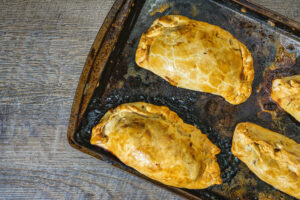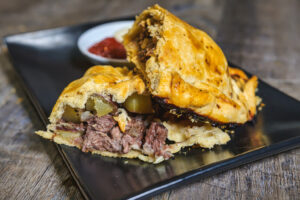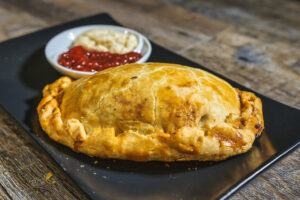In the United States the word “pasty” (pronounced like “hasty“) is often linked to a type of food called a pasty (pronounced as PASS tee) than a cover. Residents of Michigan and Montana are quite familiar, with pasties knowing how they taste, how they’re pronounced and understanding their significance.
Recognized as “Irish Butte” Pasties, in Montana these delectable moon shaped pastries are filled with a blend of meats and vegetables then cooked over an open flame. A traditional and time honored method of preparing pasties. Back in the day they used to weigh around two pounds each. Nowadays they are much smaller. To paint a picture think of them as akin to calzones, with a culinary heritage baked right in.
Pastys origins are intertwined with the gold, tin and copper mining frenzy of the 1800s, in Montana.

Irish Catholic priests, in the crafted pasties to carry food while traveling through the countryside to help people. Cornish miners favored these snacks filled with sustenance. When Irish and Cornish immigrants arrived during the gold rush they brought along the tradition of enjoying pasties introducing them to our state.
Miners wielded their shovels to warm up the pastries, above the candle flames perched on their helmets. A few clutched onto the edge tailored for gripping. After finishing the insides they tossed the edge around to appease the spirits of departed miners. It seemed that hungry ghosts were not spirits. Interestingly holding the pastry by its edge reduced the chances of falling ill from hands tainted by labor.
In 1864 Finnish settlers drew inspiration from miners and settlers embracing the pasty as their creation. This led to the misconception that the dish originated from Finland, which’s incorrect. The simple and straightforward history of the pasty reflects its taste as it is typically seasoned with salt and pepper. In Butte it might be accompanied by a side of gravy or ketchup. Beyond that bold and exotic flavors are not a focus when it comes to enjoying a pasty.
Similar, to the people of Montana who enjoy eating pasties this traditional dish embodies qualities of practicality, humility and resilience without boasting inspiring us to share and showcase the recipe as a tribute, to our Montana roots.
Ingredients Butte Pasty

For the Pie Crust
- 2 ½ cups all-purpose flour
- 8 oz. unsalted butter very cold, cut into ½ inch pieces
- 1 tsp kosher salt
- 7-9 TBSP ice water
- For the Traditional Pasty Filling
- 10 oz. beef chuck trimmed, cut into 1-inch cubes
- 10 small potatoes cubed
- 1 small onion finely diced
- 1 egg beaten
- Kosher salt
- Freshly ground black pepper
For the Cheeseburger Pasty Filling
- 1/2 ib. ground beef
- 1/2 cup sharp white cheddar grated
- 1/2 cup white mushrooms sliced
- 1 TBSP onion finely diced
- 1 TBSP ketchup
- Kosher salt
- Freshly ground black pepper
- Instructions

For the Pie Crust
- Sift together the flour and salt in a large bowl.
- Add the cold butter pieces and work it in with your hands until you have a pea-sized texture
- Slowly pour the ice water into the mixture one tablespoon at a time until the dough begins to come and looks slightly shaggy. It’s more, about how it feels than anything.
- Cut the dough into four parts. Flatten each piece into circles the size of dinner plates.
- For the Traditional Pasty Filling
- Mound the beef, potato, and onion on one side of the pie dough.
- Fold the dough in half. Press the edges together to seal it. Repeat these actions three times to create pastries.
- Place the pasties on a baking sheet about one inch apart. Brush the tops (or use your fingers, the best tool for the job) with a beaten egg.
- Bake the pasties at 350°F oven for about one hour.
For the Cheeseburger Pasty Filling
- Mound the ground beef mixture on one side of the pie dough.
- Fold, seal, and bake the same as the traditional pasty.
- Serve and enjoy

I spent a good bit of my 20’s touring the country playing music. As a teenager, and throughout my 20’s, in between music, I always worked in restaurants, in various capacities. Somewhere in my late 20’s I realized that I was not on the cover of Rolling Stone, as planned, and so, I started thinking about my future and trying to figure out other ways to have an impact, be creative and still live a bit of that rock ‘n roll lifestyle. The restaurant industry provided me with a good bit of those things. And so, I started honing my chops in the kitchen, putting my nose in food lover’s companion, and really started to go somewhere with it.